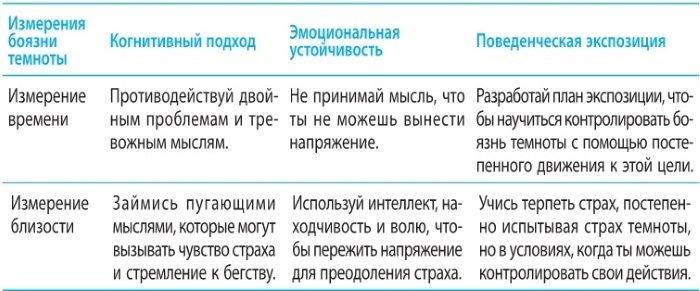Content
- What is CNS depression syndrome in newborns?
- Reasons for development
- Pathogenesis
- Classification
- Light form
- Moderate severity of violations
- Expressed violations
- Symptoms and clinical presentation
- Diagnostics
- Physical examination
- Laboratory diagnostics
- Instrumental diagnostics
- Medical genetic consultation and differential diagnosis
- Osteopathic examination
- Possible diagnoses for CNS lesions in newborns
- Treatment
- Osteopathic treatments
- Physiotherapy
- Massage
- Possible consequences
- Violation of adaptation of the baby in later life
- Decreased physical activity
- Psycho-emotional discomfort
- Oppression Syndrome Videos
In recent years, newborns have more often registered damage to the central nervous system (CNS), one of the varieties of which is the syndrome of oppression. Doctors are concerned about this fact, so the number of such cases can be equated to an epidemic. More and more parents of children under 1 year of age begin to visit pediatric neurologists and pediatricians, complaining of increased child activity or, conversely, developmental delay. As a rule, this is a serious consequence of the pathology transferred during childbirth or within a few days after them.
What is CNS depression syndrome in newborns?
Most diseases in children develop in the future due to the fact that the problems of the central nervous system were not identified in a timely manner (they are more difficult to identify in the first days after birth). According to statistics, 85% of newborns who subsequently died had spinal or brain injuries. From this we can conclude that damage to the nervous system can occur directly during childbirth. This is due to hydrocephalus, developmental delay, paralysis, visual impairment, and more.
The syndrome of oppression in newborns is one of the consequences of perinatal encephalopathy. It is a large group of neonatal brain lesions that occur during pregnancy or during childbirth. Accordingly, the syndrome of depression of the central nervous system can also be called one of the manifestations of perinatal encephalopathy. There can be many of them.
Most often, children suffer from neuro-reflex excitability or from depression syndrome. The latter is characterized by a weakened reaction of the newborn child to the world around him. General lethargy and additional symptoms may appear.
Reasons for development
CNS depression in a newborn is more often diagnosed against the background of ischemic or hypoxic lesions. Hypoxia occurs due to a lack of oxygen, which does not enter the baby's bloodstream during childbirth. As a rule, this happens when childbirth is too long or when a woman is diagnosed with a weak birth force. In rare situations, hypoxic damage occurs due to an abnormality of the placenta or umbilical cord.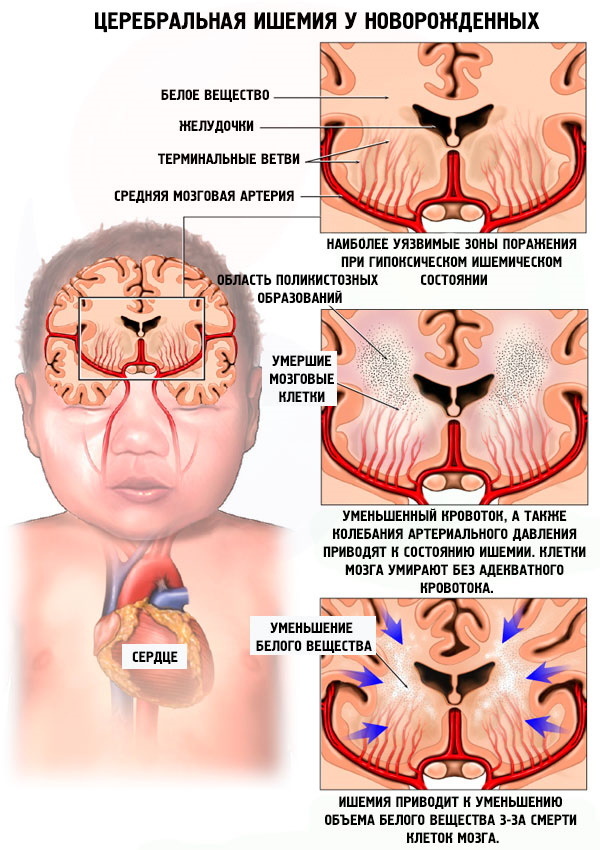
Ischemia is characterized by a complete lack of oxygen, which leads to the death of human brain cells. This can occur in any part of the cerebral cortex, respectively, the picture of diseases in the future may differ.
Also, depression of the central nervous system can be provoked:
- Traumatic injury. In most cases, this problem also occurs during childbirth. The reason may be too rapid labor activity (for example, when the baby's head passes very quickly through the birth canal, due to which the newborn already appears with an injury). As a rule, such problems are encountered if the fetus is very large. Also, traumatic damage to the central nervous system can occur due to unskilled actions of obstetricians.
- Infectious as well as toxic damage. This can happen if the mother of the child suffers from a viral infection, abuses alcohol and smoking in the process of carrying a child.
Most often, brain damage occurs due to ischemic or hypoxic nature. When injured, the spinal cord suffers more. To reduce the risk of such a development of CNS damage, it is recommended to give birth exclusively in a proven maternity hospital and carefully study the recommendations of the selected obstetrician. In the first days after discharge, it is necessary to visit specialists and conduct a full examination of the child.
Also, deviations can occur against the background of health problems in a pregnant woman. For example, this happens if she suffers from diabetes, heart disease, bronchial asthma, chronic diseases and much more. Also, the risk of developing CNS depression in a newborn increases sharply if pregnancy is not going well (for example, when the doctor talks about the threat of miscarriage or the presence of intrauterine infection). There is also such a thing as pathological childbirth. This means that a woman may have a too narrow pelvis.
To reduce most of the risks, you need to give up bad habits during pregnancy, stop taking medications, especially those that are potentially harmful to fetus. In addition, it is important that a woman works in an ecologically safe atmosphere and does not engage in heavy physical labor. But even under favorable conditions, there is a risk that hypoxic encephalopathy can develop after the birth of a child, that is, during the first days of a newborn's life. This is due to respiratory distress, heart defects and sepsis.
Pathogenesis
Regardless of what reasons led to the development of this pathology, in almost all situations, the trigger is precisely the lack of oxygen. Other disorders, such as hypoglycemia, hypocalcemia, etc., are the result of hypoxic lesions of the central nervous system.
Classification
The syndrome of oppression in newborns is still being studied by specialists. Today they distinguish 4 main degrees of damage.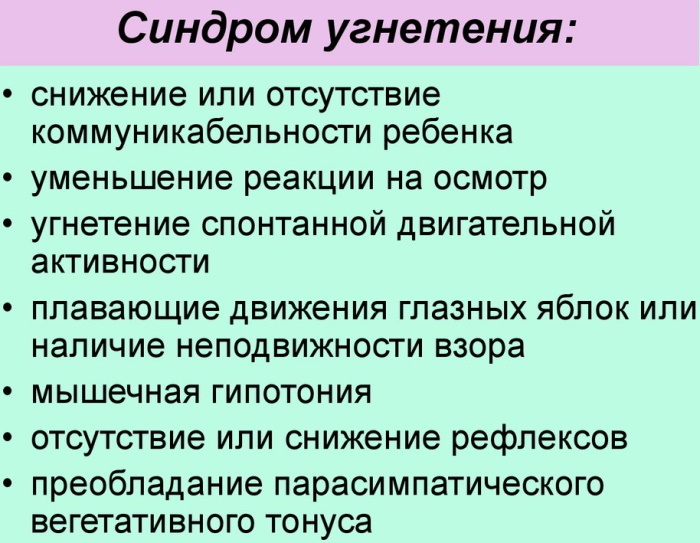
| Degree of CNS depression syndrome | Description |
| Lethargy | It is characterized by the fact that a newborn child spends almost all the time in a dream. He can only wake up from external stimuli. But if you leave him alone, he quickly falls asleep again. |
| Deafening | In this state, the child is only able to respond to tactile stimuli by frowning or changing facial expressions. At the same time, he moves very weakly. During the examination, the doctor may provoke a grasping reflex, but all other movements will be absent. |
| Stupor | With such a degree of depression of the central nervous system, the child is very poorly able to respond to external stimuli, and any reaction is observed only when pain occurs. In all other respects, the clinical picture is exactly the same as with stunnedness. |
| Coma | It means that the child does not react at all, even to painful stimuli. In a 1st degree coma, a newborn may retain certain reflexes, but only at the level of the brain stem. If a coma of the 2nd degree occurs, then even the reflexes of the stem level disappear. |
In most situations, the absence of a stem-level reflex is the main indication that very serious brain damage has occurred. Moreover, most often doctors give very unfavorable forecasts. If, upon exiting a coma, the child still has a complete absence of reflexes, then this indicates persistent neurological disorders.
Also, in the process of development of perinatal encephalopathy, doctors determine the acute period, which lasts the first month of a child's life. After that, up to 4-6 months, an early recovery period is recorded, and the late recovery period can last up to two years of age. Even so, some symptoms of weakened reflexes to stimuli may remain.
Also, there are 3 forms of this deviation, which are also characterized by a point system. The more points, the less severe the form is considered.
Light form
The syndrome of oppression in newborns in this form is estimated at 6-7 points. The main symptom of mild perinatal encephalopathy is increased neuro-reflex excitability. 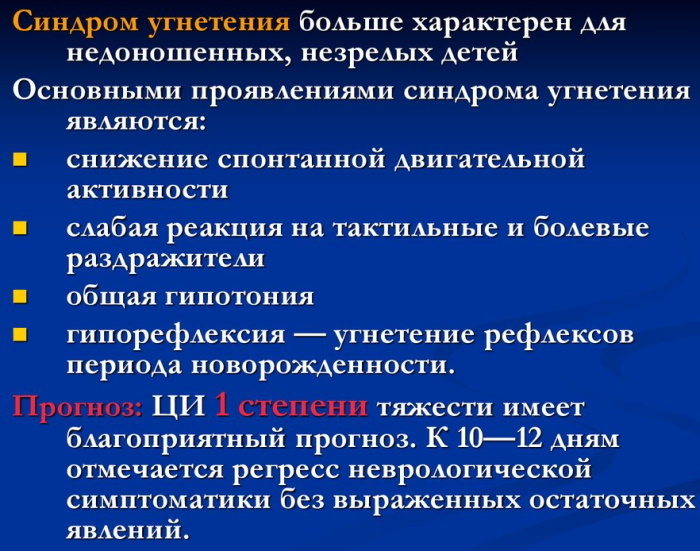 Or, on the contrary, the syndrome of oppression is diagnosed. If the baby is premature, then even a mild form is considered difficult, since in this case we are talking about an increased risk of developing convulsive syndrome, which is extremely dangerous for newborns.
Or, on the contrary, the syndrome of oppression is diagnosed. If the baby is premature, then even a mild form is considered difficult, since in this case we are talking about an increased risk of developing convulsive syndrome, which is extremely dangerous for newborns.
Moderate severity of violations
Estimated at 4-6 points. In this case, perinatal encephalopathy, as a rule, proceeds exclusively with the syndrome of oppression. 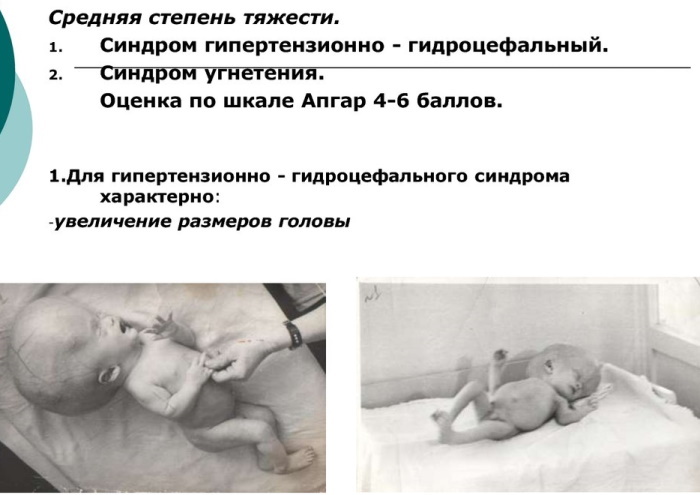 Also, children are often diagnosed with hypertensive-hydrocephalic syndrome.
Also, children are often diagnosed with hypertensive-hydrocephalic syndrome.
Expressed violations
Estimated from 1 to 4 points. This is a severe form of perinatal encephalopathy, in which a coma or pre-comatose state can be observed. This is an extremely serious condition that often does not go away without leaving a trace, and even after successful therapy, the child may suffer from inhibition of some reflexes.
Symptoms and clinical presentation
The main manifestations of depression of the central nervous system are lethargy, hypodynamia, hyporeflexia. In newborns, reflexes disappear, up to the lack of the ability to swallow milk. The syndrome of oppression can occur simultaneously with arousal.
In the case of 2 such different conditions, there is a risk of developing seizures or strabismus. Children are diagnosed with sagging lower jaw or lack of muscle activity, which is responsible for facial expressions. In some cases, pronunciation disorders may develop. Also, depression syndrome can be accompanied by a decrease in the emotional state, pain reaction.
The manifestation of the symptoms of such a deviation directly depends on how severe the form of the disease is in the child. If the depression is mild, then in this case the symptoms can be so insignificant that the parents of the newborn only note the child's slight lethargy and lack of activity with his hand.
If we are talking about the moderate severity of CNS depression, then, as a rule, children have a pronounced violation swallowing reflex, hyperreflexia is manifested, which at the same time can laugh with hypertonicity muscles. In severe cases, children develop convulsions, intestinal paresis, respiratory system disorders and adrenal hypofunction.
The main difficulty in diagnosing this deviation is that pathologies of this type may not appear immediately. The longer the abnormality is diagnosed, the more difficult it will be to treat in the future. In the first days of a child's life, you can see only very serious manifestations that are characteristic of a severe form of the disease.
That is why the greatest danger is represented by convulsions that appear in the first day after the birth of a child. Also, from the additional symptoms, frequent regurgitation and choking of the child can be distinguished. Some parents identify motor dysfunctions.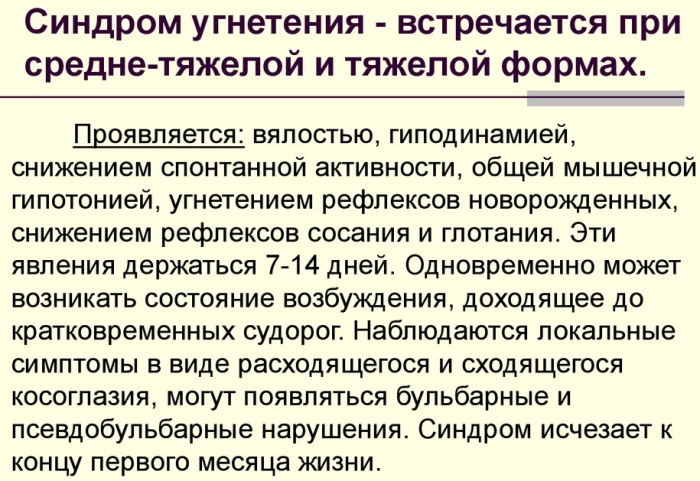
To determine on your own whether a child has similar problems, you can conduct a simple screening test. However, he will give results only if the fetus has been full-term for the entire expected period. If the child is already 2 months old, then he must hold the head while lying on his stomach. At 6 months you can try to plant it. At the same time, he should independently remain in a sitting position without any problems. At 12 months, the child should already begin to walk on his own. However, such tests will only determine the presence of problems by 1 year.
If a child has a traumatic injury in the spinal cord, then in this case such reactions will be delayed by 1-2 months. This delay is not considered very serious (when compared with brain damage). Based on how quickly the child develops, you can at least approximately determine the presence of neurological abnormalities in him and contact the appropriate specialist. However, you should not panic ahead of time.
Diagnostics
The syndrome of oppression can be detected in newborns directly during the examination and physical examination. To do this, it is worth visiting a pediatrician or pediatric neurologist. It is necessary to prepare all the data on how the pregnancy proceeded, childbirth, in what condition the child was immediately after birth.
To more accurately determine the presence of brain damage and assess the level of severity of damage, it is necessary to perform additional laboratory and instrumental studies. As a rule, first of all, the doctor directs the patient to an ultrasound examination, during which the anatomical structures of the brain are studied. This makes it possible to exclude hypoxic-ischemic changes. CT or MRI of the brain is also done. Additionally, other analyzes can be performed.
Physical examination
During it, the doctor conducts a standard examination of the child and determines his general condition, as well as physical development. The doctor conducts several tests to assess the patient's neurological status. To do this, the specialist pays attention to what posture the child takes, in what position his body is. It also identifies basic reflexes (spontaneous or stimulated). Additionally, psychomotor development is assessed.
Laboratory diagnostics
To identify deviations, it is necessary to conduct a clinical blood test. If the patient really has perinatal pathology, then a change in the level of leukocytes will be detected.
A clinical analysis of urine is also being carried out. If there are abnormalities, the tests can show data that also indicate problems with the child's central nervous system. Usually, doctors additionally conduct blood biochemistry and determine alkaline phosphatases. This test eliminates the likelihood of developing rickets, one of the symptoms of which is muscle hypotonia. That is, it may turn out that the child's symptoms are very similar to the manifestation of the depression syndrome, but there are other pathologies with similar symptoms.
Instrumental diagnostics
Such a survey includes several studies:
-
Neurosonography. It is an echographic imaging of the patient's brain. It is carried out in the first year of a child's life. Such an examination makes it possible to determine the features of the structure of the brain, its dimensions and the size of the cerebrospinal fluid zones (for example, the ventricles). Choroid plexuses are also evaluated. The doctor may detect a cyst or leukomalacia. But if the child is over 1 year old, then such a procedure will not be so effective.

- Dopplerometry, as well as dopplerography of the vascular system of the brain. During the examination, changes in the speed of blood flow in the cerebral artery can be determined. The data obtained by this method make it possible to prescribe the most effective and accurate treatment.
- Electroencephalography. In the course of the study, the specialist determines even minor changes in the bioelectrical activity of the patient's brain. This is due to the fact that the cortical rhythm matures with delays.
- ENMG. Electroneuromyography allows you to register the biopotential of the muscles. The study is carried out in two states, when the patient is tense and at rest.
Additionally, it is worth visiting an ophthalmologist who checks the condition of the fundus. With the syndrome of depression of the central nervous system, symptoms of optic nerve atrophy are observed.
Medical genetic consultation and differential diagnosis
Such counseling is carried out if the development of muscle hypotonia is suspected. Specialists perform cryotyping, as well as molecular genetic studies.
Differential diagnosis is performed when spinal amyotrophy is suspected, which is characterized by a constantly progressive course. As it develops, there is an increase in muscle atrophy. If such a deviation is not detected in a timely manner, then there is a risk of death from respiratory failure or pneumonia.
Osteopathic examination
To carry it out, you need to visit an osteopath. He will conduct a standard neurological examination, as well as tests that will help identify abnormalities in the structure of the skull, ribs, cervical vertebrae and other areas. Sometimes abnormalities may be in an area that does not seem to lead to problems with the central nervous system.
Osteopathic examination is performed in several stages:
- First, the doctor determines the arches of the body, whether the limbs are correctly positioned. During the examination, the specialist also assesses how the child is behaving, whether he is in pain, whether he is behaving aggressively, or, conversely, does not pay attention to the touch of the osteopath.
- After that, the amplitude, as well as the rhythm and strength of the patient's breathing, is assessed.
- Next, the specialist evaluates the pattern of the craniosacral system.
- The doctor also conducts tests to determine how mobile the child's cervical and lumbosacral spine is.
Additionally, other tests may be prescribed, after which the osteopath will be able to more accurately represent the picture of possible anatomical abnormalities in the child. Only after carrying out a multilevel diagnosis can an accurate diagnosis be determined and treatment can be started.
Possible diagnoses for CNS lesions in newborns
As a rule, children are diagnosed with perinatal CNS damage. But the doctor can also confirm ischemic-hypoxic encephalopathy. In some cases, we are talking about a slight delay in psychomotor development. Separately, the doctor indicates a certain nature of the disorders, symptoms. He also determines the form of the course of the syndrome.
Treatment
Acute Neonatal Depression Syndrome means that treatment can only be performed in the appropriate department of the neonatal hospital. If the patient's swallowing reflex is impaired, tube feeding may be indicated. Medication is prescribed based on the symptoms of perinatal encephalopathy. If the child suffers from intracranial hypertension, a corticosteroid (such as prednisol) may be needed. A lumbar puncture may also be done.
Other events can be held:
- In order to normalize the metabolic processes that take place in the nerve tissues and reduce the risk of hypoxia, infusion therapy is performed. That is, the patient is injected with a solution of glucose, calcium, potassium, magnesium and other drugs.
- Your doctor may prescribe phenobarbital to rule out seizures.
- To improve blood circulation and metabolic processes in the brain, cortexin, vinpocetine and other drugs are prescribed.
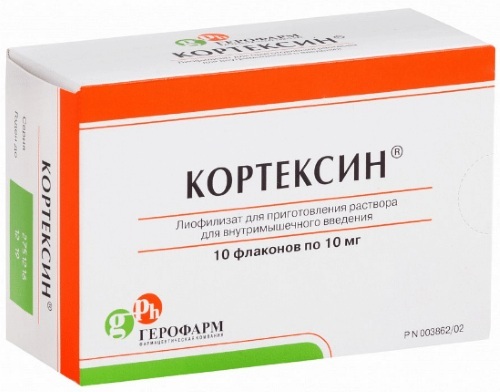
Outpatient treatment is usually prescribed if the child has begun a recovery period. Or he may be assigned to a day hospital. In addition, the doctor may prescribe drug recovery therapy.
Osteopathic treatments
This treatment is aimed at stopping anatomical dysfunctions in the newborn. It is also important to restore biomechanical processes in bones, joints and soft tissues. There are many techniques for such therapy, which are selected depending on the specific diagnosis.
For example, it can be carried out:
- Decompression of the sacrum.
- Balancing the tone of the diaphragm.
- Normalization of muscle tone. An osteopath works with the chest, first ribs, collarbones.
- Correction of blood outflow and other measures.
The main goal of treatment is to relieve stress, dysfunction and other abnormalities in the child's body so that it can function as a harmonious biomechanical system.
Physiotherapy
The type of physiotherapy procedure depends on the level of the deviation and its degree of development. The principle of such treatment is based on influencing different levels of the so-called pain system. For example, magnetic laser therapy, electrosleep, electrophoresis can be performed. High-frequency puncture (EHF) is also performed.
The use of physical factors, which are based on a systemic principle, allows you to stimulate the body's compensation functions. Such techniques are used for a wide variety of abnormalities, including problems with the central nervous system.
Massage
The syndrome of oppression in newborns can be alleviated by manual or hardware action on the body, during which the skin, subcutaneous fat, and muscles are captured. Thanks to massage, you can improve blood circulation, as well as metabolic processes in tissues. If reflex and humoral techniques are used, then the effect can also spread to the internal organs.
There are many techniques for performing massage. In case of deviations in the work of the central nervous system, relaxing, tonic and other types of influence are suitable, which are ways to lower or, conversely, increase the patient's nervous excitability.
Possible consequences
It all depends on the age of the child. If the disease was diagnosed in the 1st year of life, then with conservative therapy, neurological disorders begin to compensate by 3-6 months. In the 2nd year of a child's life, the consequences can be more serious. Complications are manifested in the form of developmental delay, and dyssomnia may appear. Children have problems during adaptation. In the 3rd year of therapy, one can count on recovery, but at the same time there remains the likelihood that the child will suffer from problems with the autonomic system, dyspelegia, and dyspraxia.
Violation of adaptation of the baby in later life
Due to the deviations that occur with the development of the syndrome of oppression, the behavior of the child can be seriously different from his peers. This can lead to difficulties in initial socialization. Children find it more difficult to adapt, but with continued therapy, problems disappear over time.
Decreased physical activity
With sluggish reflexes, physical activity also decreases, and some lethargy appears. To reduce this negative effect, massage and physiotherapy procedures help well.
Psycho-emotional discomfort
It is more difficult for a child to make contact with parents and other children. At this stage, it is important that the mother and father of the child are patient. If, along with depression, he is hyperactive, then he can behave aggressively, constantly cry. It is difficult at the psycho-emotional level, not only for the child himself, but also for his parents.
With the development of depression syndrome, it is important not to panic or despair. In newborns, this diagnosis is made quite often. Doctors are constantly improving therapeutic measures, developing new techniques that contribute to complete recovery. The main thing is to timely identify deviations of this type.
Oppression Syndrome Videos
Perinatal CNS damage:


